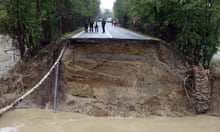Belgium, Germany and the Netherlands have recorded their highest ever temperatures as the second extreme heatwave in as many months to be linked by scientists to the climate emergency grips the continent.
The Dutch meteorological service, KNMI, said the temperature reached 39.2C (102.5F) at the Gilze-Rijen airbase near Breda on Wednesday afternoon, exceeding the previous high of 38.6C set in August 1944.
In Belgium, the temperature in Kleine-Brogel hit 38.9C on Wednesday afternoon, fractionally higher than the previous record of 38.8C set in June 1947, and then subsequently rose to 39.9C. Forecasters said temperatures could climb further on Thursday.
Germany’s national weather service, DWD, said it believed a new all-time national high of 40.5C – 0.2C higher than the record – had been set in the town of Geilenkirchen near the Dutch and Belgian borders, but had still to confirm it.
“The most extreme heat will build from central and northern France into Belgium, the Netherlands and far western Germany into Thursday,” said Eric Leister of the forecasting group AccuWeather.
After several cities in France broke previous temperature records on Tuesday, including Bordeaux, which hit 41.2C, the national weather service, Météo France, said Paris was likely to beat its all-time high of 40.4C, set in July 1947, with 42C on Thursday.
City records in Amsterdam and Brussels are also expected to fall. Cities are particularly vulnerable in heatwaves because of a phenomenon known as the urban heat island effect, in which concrete buildings and asphalt roads absorb heat during the day and emit it again at night, preventing the city from cooling.
The latest heatwave, caused by an “omega block” – a high-pressure pattern that blocks and diverts the jet stream, allowing a mass of hot air to flow up from northern Africa and the Iberian peninsula – follows a similar extreme weather event last month that made it the hottest June on record.
Quick GuideWhat is causing Europe's heatwaves?
Show
Is this a record-breaking heatwave?
Temperature records for this time of year have already been broken across much of Europe. The highest ever June temperatures were recorded in the Czech Republic, Slovakia, Austria, Andorra, Luxembourg, Poland and Germany, while France registered an all-time record high of 45.9C.
Why is it so hot?
The latest heatwave, caused by an “omega block” – a high-pressure pattern that blocks and diverts the jet stream, allowing a mass of hot air to flow up from northern Africa and the Iberian peninsula – follows a similar extreme weather event last month that made it the hottest June on record.
Is this heatwave a result of climate breakdown?
It is not possible to pin the heatwave definitively on climate change because weather varies naturally. Moreover, the effects of climate change are not simple. For example, heavy rain and cloud across northern Europe is likely to become more common as the buildup of carbon dioxide in the atmosphere causes the jet stream weather system to become fixed in position.
However, this year’s weather is certainly in line with the predictions scientists have made of rising temperatures, more heatwaves and prolonged droughts interspersed with periods of heavy flooding.
What are the negative impacts of a heatwave?
The body’s ability to regulate its own temperature is crucial; babies and older people are less well able to regulate their temperature and should stay in well-ventilated conditions. In the 2003 European heatwave there were about 70,000 excess deaths attributed to the long hot spell. People with underlying illnesses can also have problems, and even those who are healthy can experience difficulty sleeping and discomfort, so people are advised to stay hydrated and wear loose clothing at night.
There is also an impact on farmers. While warmth at the right time is crucial for crop growth, excessively high temperatures can inhibit that growth, particularly if they are prolonged. Livestock can also suffer in the heat and need extra care.
Fiona Harvey Environment correspondent
The highest ever June temperatures were recorded in the Czech Republic, Slovakia, Austria, Andorra, Luxembourg, Poland and Germany, while France registered an all-time record high of 45.9C in the southern commune of Gallargues-le-Montueux.
Clare Nullis, a World Meteorological Organization spokeswoman, said the heatwaves bore the “hallmark of climate change”. The extreme events were “becoming more frequent, they’re starting earlier, and they’re becoming more intense”, she said. “It’s not a problem that’s going to go away.”
The 26-28 June heatwave in France was 4C hotter than a June heatwave would have been in 1900, according to World Weather Attribution, a new international programme helping the scientific community to analyse the possible influence of climate breakdown on extreme weather events.
A study published earlier this year by the Swiss Federal Institute of Technology in Zürich said the summer heatwave across northern Europe last year would have been “statistically impossible” without climate change driven by human activity.

KNMI has issued a code orange extreme temperature warning for all of the Netherlands except the offshore Wadden Islands and implemented its “national heat emergency” plan, while Belgium has taken the unprecedented step of placing the entire country on a code red warning.
Spain has also declared a red alert in the Zaragoza region, where the worst wildfires in 20 years took place last month. The EU’s Copernicus Emergency Management Service warned of an extreme danger of further forest fires in France and Spain on Thursday, with a high or very high threat level in Belgium, Germany, Italy and Portugal.
Twenty French départements were also placed on red alert. Agnès Buzyn, the health minister, said: “Nobody is immune in the face of such extreme temperatures. There are risks even if you are not particularly vulnerable.”
Britain’s Met Office issued similar advice and said the UK all-time high of 38.5C, recorded in Faversham, Kent, in August 2003, could be exceeded on Thursday.
Local authorities in France have placed restrictions on water usage in 73 of the country’s 96 départements following dramatic falls in ground and river water levels. “It’s tricky but under control, but we need to be very vigilant,” said the junior environment minister, Emmanuelle Wargon.

The French energy company EDF said it was shutting down two reactors at its Golfech nuclear power plant in the southern Tarn-et-Garonne region in order to limit the heating of water used to keep the reactors cool.
Scientists have said such heatwaves are closely linked to the climate emergency and will be many times more likely over the coming decades.
Last month, the Potsdam Institute for Climate Impact Research said Europe’s five hottest summers since 1500 had all occurred in the 21st century – in 2002, 2003, 2010, 2016 and 2018.
Monthly records were now falling five times as often as they would in a stable climate, the institute said, adding that this was “a consequence of global warming caused by the increasing greenhouse gases from burning coal, oil and gas”.









